#rhinoptera bonasus
Explore tagged Tumblr posts
Text










feeding cownose rays [video by brave wilderness]
#stingrays#rays#cownose rays#blue#green#grey#water#animals#flap flap flap#i also flap when i see them#stingray touch tanks are so cool and fun i love petting them and feeding them and i highly recommend trying it if you're able#(they trim the stingers so it's completely safe)#batoidea#rhinoptera bonasus#my stuff#i've never made gifs before......i hope you like them#my gifs
107 notes
·
View notes
Text


Range: Western Atlantic Ocean from New England (USA) to southern Brazil
#poll#Class: Chondrichthyes#Order: Myliobatiformes#Family: Rhinopteridae#Genus: Rhinoptera#Rhinoptera Bonasus
41 notes
·
View notes
Text
Round 3 - Chondrichthyes - Myliobatiformes




(Sources - 1, 2, 3, 4)
Our first order of rays are the Myliobatiformes, or “Stingrays.” This order includes the families Zanobatidae (“panrays”), Hexatrygonidae (“Sixgill Stingray”), Dasyatidae (“whiptail stingrays”), Potamotrygonidae (“river stingrays”), Urotrygonidae (“American round rays”), Gymnuridae (“butterfly rays”), Plesiobatidae (“Deepwater Stingray”), Urolophidae (“round rays”), Aetobatidae (“pelagic eagle rays”), Myliobatidae (“eagle rays”), Rhinopteridae (“cownose rays”), and Mobulidae (“devil rays”).
Myliobatiformes are characterized by their enlarged, expanded pectoral fins being completely fused to their head and body, called a “disc”. Their disc shape ranges from diamond to subrhombic to lozenge-shaped. They are also characterized by the presence or absence of a single small dorsal fin, a long whip-like tail, and one or more stinging spines on the upper tail base (some species have secondarily lost this spine). As a defense mechanism, stingrays will flail their pointed or barbed tails and lodge the spine within a potential predator while they escape. The spine eventually grows back. As rays, their eyes and spiracles are on the dorsal side of their body while their gill slits, nostrils, and mouth are on the ventral side. Most myliobatiformes have blunt, pavement-like teeth for crushing hard-shelled prey and bony fish, though Manta Rays are planktonivore filter-feeders. They give birth to live young, usually 1-10 per litter, depending on species. This is a highly diverse group, and the second largest order of batoids (rays).
Myliobatiformes arose in the Early Cretaceous.

Propaganda under the cut:
Most stingrays are not aggressive if left alone, and some are even curious and friendly. The Cownose Rays (Rhinoptera) especially are known for this behavior, and are often the species of choice for touch tanks in public aquariums, as they will actively seek out attention. In my family’s experience, my sisters and mother were swimming in the ocean two Summers ago, and my sister patted what she thought was my mom’s foot after it bumped her on the back. She then realized it was a Cownose Ray (Rhinoptera bonasus) when another one tripped my other sister! A school of them was playing in the shallows and had decided to mess with my family. (I only ever get pinched by crabs and spooked by jellies when I enter the ocean ;_;)
Uniquely for its family, the Porcupine Ray (Urogymnus asperrimus) lacks a venomous tail spine. Instead, it defends itself with the many large, sharp thorns found over its disc and tail. Due to its thorny hide, this now endangered ray has historically been a very valuable source of shagreen.
The Giant Oceanic Manta Ray (Mobula birostris) is the largest stingray, growing up to 9 m (30 ft) long, 7 m (23 ft) wide, and weighing about 3,000 kg (6,600 lb), though the average size commonly observed is half that.
Around 35 cm (14 in) in width, the Bluespotted Ribbontail Ray (Taeniura lymma) is one of the most venomous species of stingray and is known to have an excruciating sting. Nevertheless, it is popular with home aquarists for its small size and beautiful coloration. Despite this, it is not well suited for captivity, being a very shy species and prone to refusing to feed. Seldom have hobbyists been able to keep one alive for long in home aquariums. Professional, public aquariums have had much better luck with the species, even maintaining breeding programs.
The composition of venom in freshwater stingrays appears to differ from that of marine stingrays.
Stingrays that live in the deep sea, such as the Deepwater Stingray (Plesiobatis daviesi) and the Sixgill Stingray (Hexatrygon bickelli) are flabby and almost goopy, with a skate-like appearance. The deep sea changes folks.
When threatened, the Crossback Stingaree (Urolophus cruciatus) raises its tail over its disc like a scorpion, as a warning.
Spotted Eagle Rays (Aetobatus narinari) sport 2-6 venomous, barbed spines at a time, but the most danger they have presented to humans so far is via their leaping from the water at the wrong place/wrong time! On at least two occasions Spotted Eagle Rays have been reported as having jumped into boats, and in one incident this sadly resulted in the death of a woman in the Florida Keys. Otherwise, these rays appear to be curious about humans and will sometimes slow down to inspect snorkelers if the human is not acting threatening.
The Chilean Devil Ray (Mobula tarapacana) is one of the deepest-diving ocean animals, traveling from the surface to feed at depths of up to 1,896 metres (6,220 ft). A veined structure of blood vessels warms the ray's brain at colder depths. These rays stay near warmer surface water for at least an hour both before and after deep diving, suggesting that they are soaking up heat to prepare for and recover from their descent into colder water.
Manta Rays (genus Mobula) are incredibly smart. They were the first “fish” in the world to pass the “mirror test” (ie show self-awareness by recognizing themselves in a mirror rather than seeing the reflected image as another manta ray). They also have highly-developed long-term memory, form friendships, and play with each other by blowing bubbles and breaching out of the water.
Steve Irwin’s death was a freak accident. He was swimming and passed overtop a 2 m (6.7 ft) long Short-tail Stingray (Bathytoshia brevicaudata), and the animal reacted reflexively to his shadow by stabbing its barbed tail repeatedly into what it perceived as a predator. By an insane stroke of bad luck, the spine from the stingray’s tail pierced right through into Steve’s chest. (And no, the barb did not become lodged and he didn’t pull it out; that’s a rumor. Venom or no, there’s not much you can do about being stabbed in the heart.) Fatal stings are very rare, and only around 20 stingray-related deaths have been recorded in history. Steve loved all animals and would not have wanted people to hold his death against literally all species of stingray, let alone the single one that accidentally took his life. Even as a joke, using Steve Irwin to hate on an animal does a great disservice to his legacy. So if I hear a word of stingray-hate in Steve’s name, I’m calling the guards. >:C
#let me be clear you’re allowed to dislike them but I am so very tired of seeing comments of people bringing up#’getting revenge for Steve Irwin’ or ‘hate stingrays for what they did to Steve’ every time a stingray is mentioned#I don’t care if it’s a joke it’s on ‘if it doesn’t scan does that mean it’s free’ levels of funny to me but worse because it’s on a whole#new level of comically missing the point and spitting on the ashes of the dead to boot#You may dislike the Sea Pancakes but you MAY NOT take Steve’s name In Vain about it#round 3#animal polls#chondrichthyes
100 notes
·
View notes
Text

Common eagle ray (Myliobatis aquila), Cownose ray (Rhinoptera bonasus)
Fishes of the World. Written by Hans Hvass. Illustrated by Wilhelm Eigener. Originally published in 1964.
Internet Archive
185 notes
·
View notes
Text



54 common fish of texas, part 2: atlantic stingray (Hypanus sabinus), bluntnose stingray (Hypanus say), cownose ray (Rhinoptera bonasus)
158 notes
·
View notes
Text
Day 9 of Fishuary!!
Prompt: Ray
—
RHINOPTERA BONASUS MY BELOVED. I love these guys SOOOOOO MUCH!!! Legitimately one of my most favourite animals. These guys are the best!!
Yes, these guys are stingrays! And they’re so good at it. They’re named after their uniquely shaped head-lobes, which resemble a cow’s nose apparently! I disagree but that’s my own take lmao. They have flaps underneath their eyes that help them find their food!
These guys are super curious and friendly and are frequently seen in touch tanks! These little goobers are the best I cannot express in text how much I love them. Kisses them softly <3

#artists on tumblr#art#my art#digital art#animals#fish#fishuary2024#ray#stingray#cownose ray#cownose stingray
19 notes
·
View notes
Text




Image 1 : Cownose Ray - Rhinoptera bonasus
Fun Fact : While feeding at the bottom of the ocean, cownose rays create micro-habitats for tiny invertebrates!(≧∀≦)
Image 2 : Round Ray - Urobatis halleri
Fun Fact : To camouflage, Round Rays bury themselves in mud / sand with only their eyes poking & spiracles (breathing holes under the eyes) poking out. How adorable !(^。^)
Image 3 : Spotted Eagle Ray - Aetobatus narinari
Fun Fact : Spotted Eagle Rays can jump about six feet above the ocean's surface ! They also each have their own spot pattern, like a fingerprint!(*'▽'*)
September 7 , 2023(^^)
#ocean#stingrays#stingray#salt water#marine biology#fun facts#cownose ray#eagle ray#round ray#scientific names#meow
28 notes
·
View notes
Text

The cownose ray (Rhinoptera bonasus) is a species of Batoidea found throughout a large part of the western Atlantic and Caribbean, from New England to southern Brazil (the East Atlantic populations are now generally considered a separate species, the Lusitanian cownose ray (R. marginata)).[2] These rays also belong to the order Myliobatiformes, a group that is shared by bat rays, manta rays, and eagle rays.[3]
2 notes
·
View notes
Text
Established Fauna:
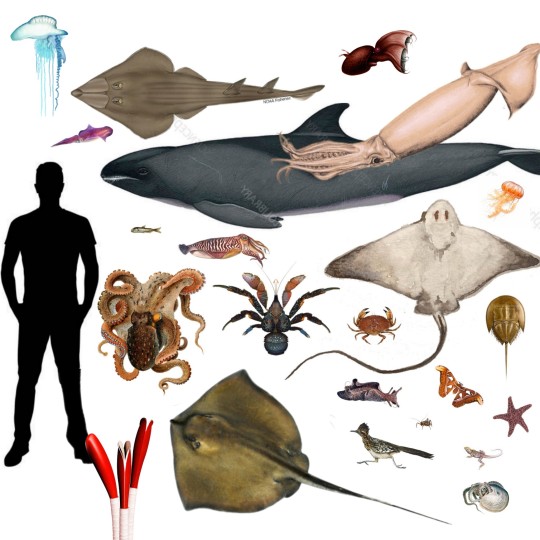
(size chart of notable fauna)
•••••••••••••••••••••••••••••••
🪶 Tetrapods:
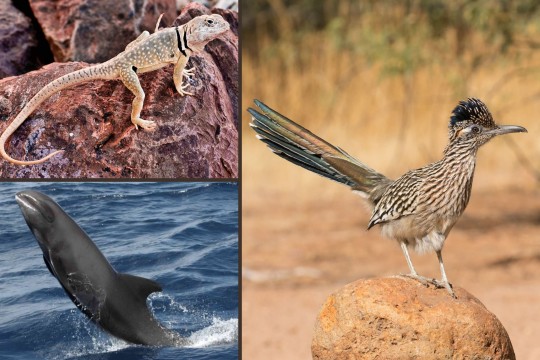
• Melon-headed whale (Peponocephala electra)
• Greater roadrunner (Geococcyx californianus)
• Collard lizards (Genus: Crotaphytus)
🌊 Fish:

• Bat ray (Myliobatis californica)
• Common stingray (Dasyatis pastinaca)
• Cownose ray (Rhinoptera bonasus)
• Common guitarfish (Rhinobatos rhinobatos)
• Lantern fish (Family: Myctophidae)
🐚 Mollusks & Brachiopods:
Breeding: 2-9 pups twice per year
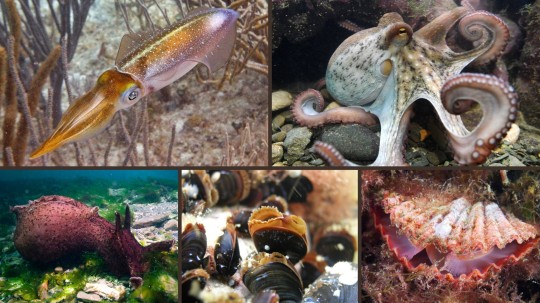
• Brachiopods
• Bivalves (Clams, Oysters, Mussels etc.)
• Gastropods
• Decapodiformes (Squid, Cuttlefish etc.)
• Octopodiformes
🦗 Arthropods:
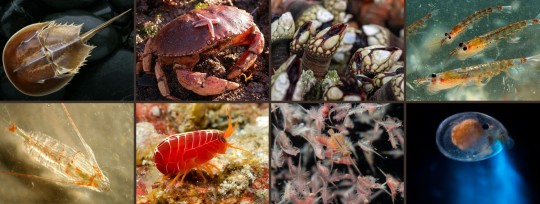
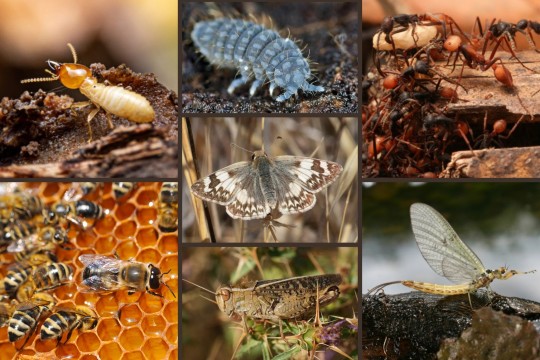
• Horseshoe crabs
• Barnacles
• Copepods
• Amphipods
• Ostracods
• Branchiopoda (Brine shrimp, Triops etc.)
• Decapods (Shrimp, Crabs etc.)
• Krill
• Springtails
• Orthoptera (Crickets, Grasshoppers etc.)
• Lepidoptera (Moths, Butterflies)
• Termites
• Ants
• Bees
• Mayflies
🪸 Other invertebrates:


• Tardigrades
• Onychophora (Velvet worms)
• Tunicates
• Crinoids
• Asteroidea (Sea stars)
• Platyhelminthes (Flat worms)
• Nematodes
• Annelids
• Cnidarians (Jellies, Anemones, Siphonophores etc.)
• Porifera (Sponges)
0 notes
Text
#cownose rays#cownose ray#This was interesting to read! A little bit hard sometimes but I understood the conclusion
0 notes
Text
I FORGOT ABOUT THIS BLOG AAA Anyways, here's an extremely late pinned post :,) Basic Info: - uhhh He/They/It pronouns, currently identifying with the Achillean label - Basic DNI, don't be a butt and we'll be cool :) - I can't read emotion in text very well, so tone indicators are pretty cool, but not mandatory when interacting with me! - Will interact with all ages, as long as the user is cool w/ it (I'm 19) - Names I go by currently are Scout, Dominic & Quill! Feel free to refer to me as any of those :) ───── ⋆⋅☆⋅⋆ ───── My therian types! Some I'm more connected to than others, but all have a connection of some sort :) - Night Fury - Toco Toucan (Ramphastos toco) - Munk's Devilray (Mobula munkiana) - Cownose Ray (Rhinoptera bonasus) - Red Wolf (Canis rufus) - Snow Leopard (Panthera uncia) - Keel-billed Toucan (Ramphastos sulfuratus) - Scarlet Macaw (Ara macao) Feel free to interact w/ this post if ur also a silly little creature, I need more creatures in my circle /pos
1 note
·
View note
Text
my biological gender pronouns are Rhinoptera / bonasus

IGYFYDHVKVDUDGOIBIJS
5 notes
·
View notes
Text




12 notes
·
View notes
Video
tumblr
Stingray Enrichment!
I’ve been working with the cownose rays at the Shedd Aquarium as a volunteer these past few weeks and it’s been interesting becoming familiar with some of the individuals. There’s quite the range of personalities and a hierarchy when it comes to feeding times.
Cownose rays, or Rhinoptera bonasus, have a large distribution as they have been seen from New England of the United States down the Atlantic to the southern edge of Brazil. They largely consume clams and scallops using a modified subrostral fin to help identify and forage for food.
This enrichment activity above is to see if the cownose rays can forage for the mussels, which are sustainably purchased through the Aquarium, in the plastic hard hat. The first time the hard hat was placed in the water, I observed very strong reactions that involved splashing and fast turns swimming away from the hat. They have definitely warmed up to the hard hat now although I’m sure the little bribe of their favorite food is extremely helpful *wink.*
By the end of the enrichment session, two of the females creeped right up to the edge of the helmet and gobbled up the mussels! Using their flat, thin, and elongate molars, they crush the mussels and slurp all the inside goodies before spitting the shell pieces out.
#marine biology#cownose rays#stingrays#rhinoptera bonasus#girls in science#girls in stem#aquarist#husbandry#chicago#stingray touch exhibit#elasmobranchii#enrichment
33 notes
·
View notes
Conversation
Stingray Feeding Time
Me: Hi sweet nuggets! Time for dinner!
Cownose rays: *nom nom nom*
Me: Ok, this was great...
Rays: As is custom with our peoples, we must grant the provider of nomz a splash in the face
Me: Really, no, that's not necessa-
Rays: WE MUST. DO. THE SPLASHY SPLASH!!!
#dammit#every time#rays are ridiculous#especially cownose rays#savages#but i love them#aquarist#aquarist life#always covered in water#cownose ray#stingray#Rhinoptera bonasus#elasmobranch#pancake sharks#aquarium#marine biology#i think i'm funny#sea nerd
437 notes
·
View notes
Text

You get a Cownose Ray
Rhinoptera bonasus

51 notes
·
View notes